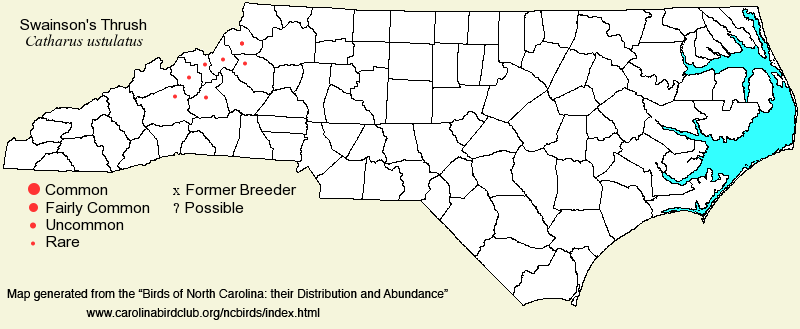 |  |
|
Swainson's Thrush - Catharus ustulatus TURDIDAE Members: | Search Common: Search Scientific: |
|
|
|||||||
| General Comments | The Swainson's Thrush is another thrush that nests across the boreal forest zone of Canada, south into the Rockies and part-way down the Appalachian chain. Interestingly, despite "global warming", the range in the Appalachians has slowly been moving southward, such that a few singing males (and hopefully females) are now present in several spruce-fir forests in North Carolina. However, despite the likelihood that it currently nests, no conclusive evidence has yet been found. Interestingly, the Hermit Thrush also occupies essentially all of the spruce-fir stands where the Swainson's occurs, and the Veery occurs with them or at least occurs just below them in elevation. How these similar thrushes partition the micro-habitats within the spruce-fir zone is an unanswered question. Across the rest of the state, this is an uncommon to at times fairly common migrant (slightly more numerous than Veery, and definitely more numerous than Gray-cheeked and Bicknell's). Like them, it occurs mainly in mature hardwood forests, with a moderately dense understory and shrub zone. There are a number of winter reports, but only one seems to be corroborated by photographs (but no specimens); few if any have been studied by experienced birders, and reports between early Dec and 15 Apr are likely not valid. | ||||||
| Breeding Status | Breeder | ||||||
| NC BRC List | Definitive | ||||||
| State Status | SR | ||||||
| U.S. Status | |||||||
| State Rank | S1B | ||||||
| Global Rank | G5 | ||||||
| Coastal Plain | Transient. In spring, uncommon in the western portion, but rare in the central and eastern portions. In fall, generally uncommon throughout. Mainly early to mid-May and mid-Sep to mid-Oct. One was quite late at Theodore Roosevelt Natural Area (Carteret) on 24 Nov 2018, as was another photographed at Airlie Gardens (New Hanover) from 22-26 Nov 2024. Perhaps the only "winter" record seems to be one at Airlie Gardens on 6 Dec 2020. Peak counts: | ||||||
| Piedmont | Transient. Uncommon to fairly common across the region, both in spring and fall; probably more numerous in fall, but as it does not sing in fall, it is easily overlooked. Mainly late Apr to late May, and mid-Sep to mid-Oct. One photographed at Cowans Ford refuge (Mecklenburg) on 25 Nov 2019 was extremely late, but a first in winter was one noted in Durham from 3-18 Dec 2020. Peak counts: | ||||||
| Mountains | Very rare summer resident, but declining since about 2020, and very few are now present in the breeding season. Almost certainly is breeding (both pre-1900 and after a lapse of over 100 years, post-2000) at a few sites; transient throughout. A few birds occur in the breeding season in the Black Mountains (Mount Mitchell and along the adjacent Blue Ridge Parkway), Roan Mountain area, and Grandfather Mountain. A nest was reported on Craggy Mountain (Buncombe) on 20 May 1896. However, by 2024, the species seems to be nearly gone as a breeder, with just a single summer report. Uncommon to fairly common in both spring and fall, but more numerous in fall; can be common to occasionally very common after cold fronts in fall, at higher elevations. Mainly early to late May, and mid-Sep to mid-Oct. One winter record, with photographs (on the Carolina Bird Club Photo Gallery) -- Beaver Lake (Buncombe) from 2-6 Jan 2019* [Chat 83:63 link]. Peak counts: in the breeding season, up to 6 singing males in the Black Mountains (Yancey) from 1 Jun - 17 Jul 2013. | ||||||
| Finding Tips |
Finding the species in migration is always "chancey", so you need to bird at parks or refuges in the first half of May, or from late Sep to mid-Oct. They are more vocal in spring, when males sing in migration. You might want to try stopping at overlooks on the Blue Ridge Parkway in Jun, in the vicinity of the road to Mount Mitchell SP. Birding along the Parkway in late Sep the day after a cold front can often produce a dozen or more birds. ** to *** | ||||||
| Attribution | LeGrand[2025-10-22], LeGrand[2025-02-04], LeGrand[2024-11-07] | ||||||
| NC Map Map depicts all counties with a report (transient or resident) for the species. | Click on county for list of all known species. |
| NC Breeding Season Map Map depicts assumed breeding season abundance for the species. |  |